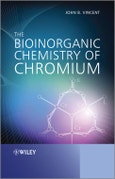The Bioinorganic Chemistry of Chromium: From Biochemistry to Environmental Toxicology takes a critical look at what the biochemical data indicate about chromium's role in the body and the biological mechanisms of its toxicology. Topics covered include:
- What do we know about the biochemical roles and mechanisms of chromium?
- Is chromium an essential element in the mammalian diet?
- Is chromium(III) effective as a nutraceutical, a therapeutic agent, and as a supplement in animal feed?
- What is the biochemistry behind the toxicology of chromium(III) and chromium(VI):the mechanisms of metabolism, genetic and epigenetic effects, and disruption of cell signalling?
- What are the current chromium(VI) policies and positions from regulatory agencies?
The Bioinorganic Chemistry of Chromium: From Biochemistry to Environmental Toxicology is an important contribution to the bioinorganic and trace element biochemical fields which will find a place on the bookshelves of bioinorganic chemists, biochemists, inorganic chemists, toxicologists, nutritionists and regulatory affairs professionals.
Table of Contents
Preface ixAcknowledgements xiii
1 Introduction – The Current Status of Chromium(III) 1
References 5
2 Is Chromium Essential? The Evidence 7
2.1 ‘Chromium-Deficient’ Diet Studies with Rats 9
2.2 Total Parenteral Nutrition 11
2.3 Chromium Absorption Versus Intake and the Transport of Chromium by Transferrin 12
2.4 Chromium Movement Related to Stresses 21
References 25
3 The Story of Glucose Tolerance Factor (GTF) 31
3.1 The ‘Identification’ of GTF 31
3.2 Brewer’s Yeast ‘GTF’ 35
3.3 Biological Activity Assays 39
3.4 Porcine Kidney Powder ‘GTF’ 40
3.5 Other Questions Regarding ‘GTF’ 40
3.6 Conclusions about GTF 41
3.7 The Race to Synthesize a Model of ‘GTF’ 42
3.8 Related Animal Studies 43
References 48
4 Is Chromium Effective as a Nutraceutical? 55
4.1 Chromium Picolinate Absorption 55
4.2 History of Chromium Picolinate as a Nutritional Supplement 57
4.3 Chromium Picolinate Toxic Effects? 73
4.4 Inorganic Chemistry of Chromium Picolinate 73
References 75
5 Is Chromium(III) Effective as a Therapeutic Agent? 81
5.1 Human Studies 85
5.1.1 Type 2 Diabetes 85
5.1.2 Subjects with Insulin Resistance or Glucose Intolerance 98
5.1.3 Other Forms of Diabetes 98
5.1.4 Atypical Depression and Related Conditions 99
5.1.5 HIV and PCOS 101
5.2 Rat Studies 102
5.3 Conclusion 114
References 115
6 Biochemical Mechanisms 125
6.1 The Insulin Signalling Pathway 125
6.2 Chromium Transport and Excretion 127
6.3 LMWCr/Chromodulin 132
6.4 Synthetic Models of LMWCr 144
6.5 Proposed Mechanisms of Chromium Action 149
6.5.1 Direct Chromium Binding to Insulin Receptor 149
6.5.2 Akt 151
6.5.3 Cholesterol 152
6.5.4 Chromate 152
6.5.5 Cytokines 154
6.5.6 Insulin Receptor Number 155
6.6 Comparison of Cell Culture Studies by Cell Type 155
6.6.1 Skeletal Muscle 155
6.6.2 Hepatocytes 156
6.6.3 Adipocytes 156
6.7 Conclusion 158
References 159
7 Menagerie of Chromium Supplements 169
7.1 Chromium Picolinate 169
7.2 Chromium Nicotinate (or Chromium Polynicotinate) 170
7.3 Chromium Histidine 172
7.4 Chromium454 173
7.5 Chromium Nanoparticles 173
7.6 Chromium Small Peptide Complexes (CrSP) 174
7.7 Dinakrome 174
7.8 Chromium(D-phenylalanine)3 174
7.9 Chromium Nicotinate Glycinate (or Chromium Dinicotinate Glycinate) 175
7.10 Chromium Pidolate 175
7.11 Chromium Methionine or Chromium Methionine Chelate 176
7.12 Cr3/Kemtrace 176
7.13 Closing Thoughts 179
References 179
8 Potential Use of Chromium in the Farm Livestock Industry 189
8.1 Previous Reviews 189
8.2 Approved Use of Chromium Supplements 191
8.3 Safety 191
8.4 Conclusions 192
References 192
9 Toxicology of Chromium(III) 195
9.1 Chromium Picolinate 198
9.1.1 Ames Assays 198
9.1.2 Cultured Mammalian Cells 199
9.1.3 Drosophila Studies 200
9.1.4 Mammalian Studies (Intravenous or Intraperitoneal) 201
9.1.5 Mammalian Studies (Oral) 202
9.1.6 Neurological Effects 204
9.1.7 In Vitro Studies 204
9.1.8 Reconciling In Vitro and In Vivo Studies 205
9.2 Chromium Nicotinate 207
9.3 Cr3/Kemtrace 208
9.4 Conclusions 208
References 209
Conclusion 215
Index 217








